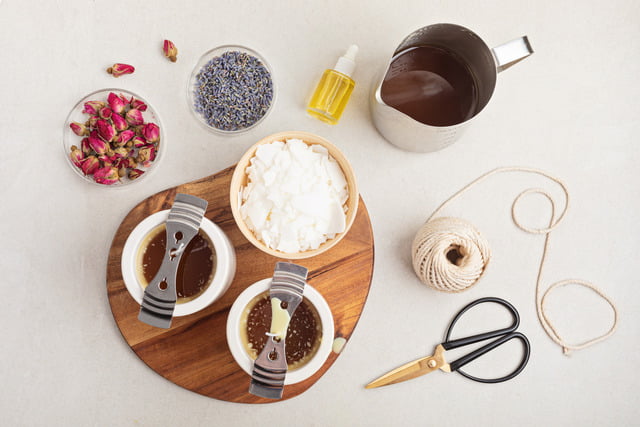Are you interested in learning the art of soy candle making? Whether you’re a beginner or an experienced candle maker, mastering the craft of soy candle making can be both enjoyable and rewarding.
In this article, we’ll explore various tips and tricks for creating beautiful, high-quality soy candles right in the comfort of your own home. From choosing the right soy wax to troubleshooting common problems, we’ve got you covered with expert advice on every step of the process.
Soy candle making has gained popularity in recent years due to its eco-friendly nature and clean-burning properties. If you’re looking to delve into this craft, it’s essential to familiarize yourself with the fundamentals and best practices.
In this section, we’ll provide valuable insights into getting started with soy candle making, including tips and tricks for achieving success. By following our expert advice on
One of the first steps in mastering the art of soy candle making is choosing the right type of soy wax for your candles. With numerous options available in the market, selecting the best soy wax that meets your specific needs can be daunting.
We’ll guide you through this process by outlining key factors to consider when choosing soy wax, helping you make informed decisions for your candle-making endeavors. Whether you’re aiming for long-lasting burn times or optimal scent throw, our comprehensive tips and tricks will set you on the path to creating superior quality soy candles.
Choosing the Right Soy Wax for Your Candles
When it comes to making soy candles, choosing the right soy wax is crucial to the success of your candle-making endeavors. The type of soy wax you use will greatly impact the quality, burn time, and overall performance of your candles. There are several factors to consider when selecting the appropriate soy wax for your candle-making project.
Types of Soy Wax
There are various types of soy wax available in the market, each with its own unique characteristics. For beginners, it’s important to understand the differences between container wax and pillar wax. Container waxes are designed for use in jars or containers, while pillar waxes are suitable for making freestanding candles. Understanding these distinctions will help you choose the right type of soy wax for your specific candle-making needs.
Considerations for Choosing Soy Wax
In addition to the type of wax, other factors should be taken into account when choosing soy wax for your candles. Consider factors such as fragrance load, color retention, and ease of use. Some soy waxes may require specific techniques or additives to achieve optimal results. Researching and understanding these considerations will help you make an informed decision when selecting the right soy wax for your candles.
Tips for Choosing Quality Soy Wax
When shopping for soy wax, it’s important to look for high-quality products from reputable suppliers. Look for soy waxes that are specifically formulated for candle making and have a good reputation among crafters. Reading reviews and seeking recommendations from experienced candle makers can also help you source the best soy wax for your candle-making projects.
By carefully considering the type of wax, key factors, and product quality, you can ensure that you choose the right soy wax for your candles and set yourself up for successful candle-making endeavors using soy candle making tips and tricks“.
Essential Oils and Fragrance Oils
The use of essential oils and fragrance oils in soy candle making can greatly enhance the overall appeal and experience of the finished product. When choosing and using these oils, there are several factors to consider in order to achieve the desired scent and effect.
Choosing the Right Oils
When selecting essential oils or fragrance oils for your soy candles, it is important to consider the strength of the scent, as well as how well they will mix with the soy wax. Essential oils are derived from natural sources such as plants, flowers, and herbs, while fragrance oils are synthetic and may offer a wider range of scents. It’s important to choose high-quality oils that will complement the natural scent of soy without overpowering it.
Using Oils Properly
To ensure that the fragrance of your soy candles is long-lasting and pleasant, it’s crucial to use essential oils or fragrance oils properly. Be sure to follow recommended guidelines for how much oil to add based on the amount of wax you are using. Additionally, consider when to add the oils during the candle making process – adding them too early can cause them to evaporate or weaken, while adding them too late can result in uneven distribution.
Tips for Enhancing Scent
For those looking to create custom scents or enhance existing ones, blending essential oils or fragrance oils can be a great way to achieve unique results. Experiment with different combinations and ratios to find the perfect blend for your soy candles. Keep in mind that some scents may change or intensify once the candle is burned, so testing them beforehand is recommended.
Incorporating essential oils and fragrance oils into your soy candle making process requires careful consideration and experimentation in order to create beautifully scented candles that customers will love. By choosing quality oils, using proper techniques, and experimenting with different combinations, you can create unique candles that stand out in a competitive market.
The Importance of Using the Right Candle Wicks
The choice of candle wicks is crucial in soy candle making, as it directly affects the way the candle burns. There are several factors to consider when selecting the right wick for your soy candles. One important consideration is the size of the container in which the candle will be placed.
A larger container may require a thicker wick to ensure that the entire surface area of the candle melts evenly. On the other hand, a smaller container may benefit from a thinner wick to prevent an oversized flame.
Another important factor in choosing the right wick is the type of wax being used. Soy wax, being a natural and softer wax, requires a different type of wick compared to paraffin or beeswax candles. Cotton or hemp wicks are usually recommended for soy candles due to their ability to burn cleanly and evenly with this type of wax.
It’s essential to conduct tests with various wick sizes and types before settling on one for your soy candles. This will help you determine which wick performs best in terms of flame size, burn time, and overall candle performance. Remember that each fragrance oil and colorant added to your candles can also impact how a particular wick burns, so thorough testing is key to achieving consistent results.
| Factor | Consideration |
|---|---|
| Container Size | Choose thicker wicks for larger containers and thinner wicks for smaller containers. |
| Wax Type | Select cotton or hemp wicks for soy wax candles. |
| Testing | Conduct tests with various wick sizes and types to determine the best option. |
Coloring Your Soy Candles
When it comes to making soy candles, choosing the right color is an important aspect of the process. Adding color to your candles can enhance their appeal and make them more visually appealing. Here are some essential tips for achieving the perfect hue when coloring your soy candles.
One important tip is to start with the right type of dye. There are various options available, including liquid dyes, dye chips, and powdered dyes. Each type has its own advantages and challenges, so it’s important to experiment and find what works best for you. Keep in mind that soy wax can be a bit trickier to color compared to other waxes, so finding the right dye that blends well with soy wax is crucial.
Another key tip is to start with a small amount of dye and gradually add more until you achieve the desired color. Remember that it’s always easier to darken the color than it is to lighten it, so start conservatively and work your way up as needed. Additionally, consider using a color wheel to help you mix different dyes together to create custom colors for your soy candles.
Finally, keep in mind that certain fragrances can affect the final color of your candles. Some fragrances may cause discoloration or change the hue of your wax, so be sure to test different fragrances with your chosen dyes before making a larger batch of colored soy candles.
By following these tips and experimenting with different dye options, you can achieve the perfect hue for your handmade soy candles and create beautiful and unique products for yourself or your customers.
Pouring and Setting
When it comes to making soy candles, the pouring and setting process is crucial for achieving a smooth finish. This step can make or break the overall appearance of your candles, so it’s important to pay attention to the techniques you use. Here are some tips and tricks to help you achieve that perfect, professional-looking finish for your soy candles:
- Use a thermometer: To ensure that your soy wax is poured at the right temperature, use a thermometer to monitor the heat. Different types of soy wax have different optimal pouring temperatures, so be sure to check the guidelines for the specific wax you are using.
- Avoid over-stirring: When adding fragrance oils or coloring to your soy wax, be careful not to over-stir. Over-mixing can create air bubbles in the wax, which can affect the smoothness of the finished candle.
- Choose the right pouring container: The type of container you use for pouring your soy wax can also impact the final appearance of your candles. Make sure to use a clean, dry container that is free from any dust or debris that could mar the finish of your candles.
By following these pouring and setting techniques, you can ensure that your handmade soy candles have a smooth and professional finish every time. Taking care with this step will not only enhance the appearance of your candles but also contribute to their overall quality and marketability.
Remember that practice makes perfect when it comes to candle making. Don’t be discouraged if your first few attempts don’t turn out exactly as planned – keep refining your techniques and experimenting with different methods until you find what works best for you. With time and experience, you’ll be able to consistently produce beautiful, smooth-finished soy candles that both look and smell amazing.
Troubleshooting Common Soy Candle Making Problems
When it comes to making soy candles, there are a few common issues that can arise during the process. Here are some tips and tricks for troubleshooting these problems:
1. Sinking or Cracking: If your candles are sinking or cracking after they have set, this could be due to temperature changes during the cooling process. To prevent this, make sure that your candles cool at a consistent room temperature and avoid placing them in drafty areas.
2. Wet Spots: Wet spots can appear as air pockets in the wax that cause uneven coloring and blemishes on the surface of the candle. To prevent wet spots, try using a heat gun to smooth out the surface of the candle after it has cooled.
3. Tunneling: Tunneling occurs when the candle burns down the center, leaving excess wax around the edges. To avoid tunneling, make sure to burn your candles for at least one hour per inch of diameter every time you light them.
Remember, troubleshooting common soy candle making problems is all about patience and practice. By following these tips and tricks, you can overcome these challenges and create beautiful, high-quality soy candles every time.
Creative Candle Packaging and Presentation Ideas
When it comes to selling your handmade soy candles, the packaging and presentation are just as important as the quality of the product itself. Creative and eye-catching packaging can make your candles stand out and attract more customers. Here are some ideas to spruce up your candle packaging:
1. Custom Labels: Design unique labels for your candles that reflect your brand and the fragrance of the candle. Use high-quality materials for the labels and consider including information about the scent, burning time, and care instructions.
2. Eco-Friendly Packaging: Consider using eco-friendly materials such as recycled cardboard or paper for your candle boxes or containers. This not only aligns with the sustainable nature of soy candles but also appeals to environmentally conscious consumers.
3. Gift Sets: Bundle together different scented candles or combine a candle with other related products like matches, wick trimmers, or candle holders to create attractive gift sets. This can increase the perceived value of your products and make them more appealing for special occasions like holidays or birthdays.
4. Personalization Options: Offer personalized labeling or customizable packaging options for special events like weddings or corporate gifts. This adds a personal touch and makes your candles suitable for unique gifting opportunities.
5. Seasonal Themes: Change up your packaging design according to seasons or holidays to make your candles feel timely and relevant all year round.
Additionally, consider creative ways to display your candles in-store or at craft fairs, such as using vintage crates, wooden shelves, or decorative trays to showcase them in an attractive manner.
| Idea | Description |
|---|---|
| Custom Labels | Design unique labels reflecting brand & fragrance. |
| Eco-Friendly Packaging | Use recycled materials for a sustainable touch. |
| Gift Sets | Create bundling options for special occasions. |
Marketing and Selling Your Handmade Soy Candles
In conclusion, mastering the art of soy candle making is not only about the crafting process but also about successfully marketing and selling your products. By implementing the tips and tricks discussed in this article, you can elevate your handmade soy candles from a hobby to a successful business venture.
One crucial aspect of selling your handmade soy candles is creating a strong brand identity. This involves developing a unique and recognizable name, logo, and packaging for your products. Additionally, utilizing social media platforms and e-commerce websites to showcase and sell your candles can greatly expand your reach to potential customers.
Furthermore, connecting with local markets, craft fairs, and artisanal events can provide valuable opportunities to put your handmade soy candles directly in front of interested consumers. Building genuine relationships with customers through personalized experiences and exceptional customer service can also contribute to the success of your soy candle business.
Ultimately, establishing an effective marketing strategy that highlights the quality and uniqueness of your handmade soy candles while reaching the right audience will be fundamental in driving sales. With dedication, creativity, and these valuable tips for success in marketing and selling, you are well-equipped to turn your passion for soy candle making into a thriving enterprise.
Frequently Asked Questions
What Are 3 4 Mistakes to Watch for When Making Soy Candles?
Three mistakes to watch for when making soy candles include overheating the wax, adding too much fragrance oil, and using the wrong wick size. Overheating can cause discoloration and burning, while too much fragrance can result in poor burning and soot. Using the wrong wick size can lead to tunneling or uneven burning.
How Do You Make the Perfect Soy Candle?
Making the perfect soy candle involves choosing high-quality soy wax, measuring fragrance oil precisely, and allowing the candle to cure properly. High-quality soy wax ensures a clean burn, while precise measurement of fragrance oil creates a balanced scent. Allowing the candle to cure for at least a week helps the fragrance to fully develop.
How Do You Make a Strong Scent Throw in Soy Candles?
Achieving a strong scent throw in soy candles requires using a higher percentage of fragrance oil, proper wick selection, and maximizing the surface area of the melted wax pool. Increasing the percentage of fragrance oil within safe limits enhances the scent throw, as does selecting the right wick size for an even burn.
Maximizing the surface area of the melted wax pool by trimming the wick can also help distribute scent more effectively.

Welcome to my candle making blog! In this blog, I will be sharing my tips and tricks for making candles. I will also be sharing some of my favorite recipes.





